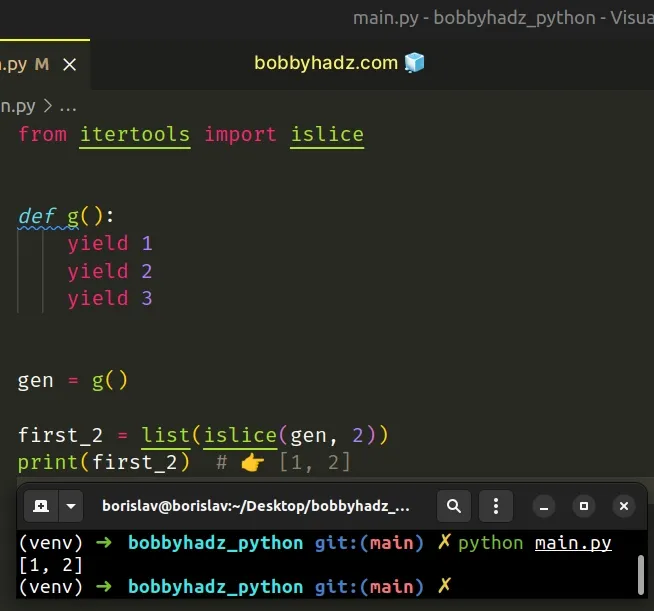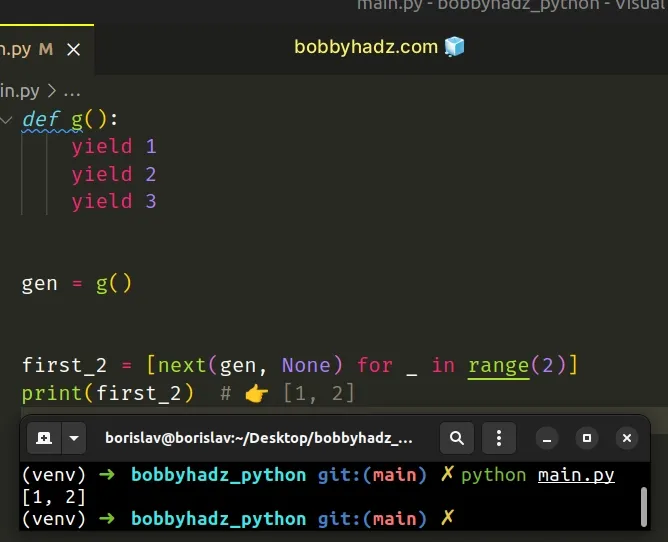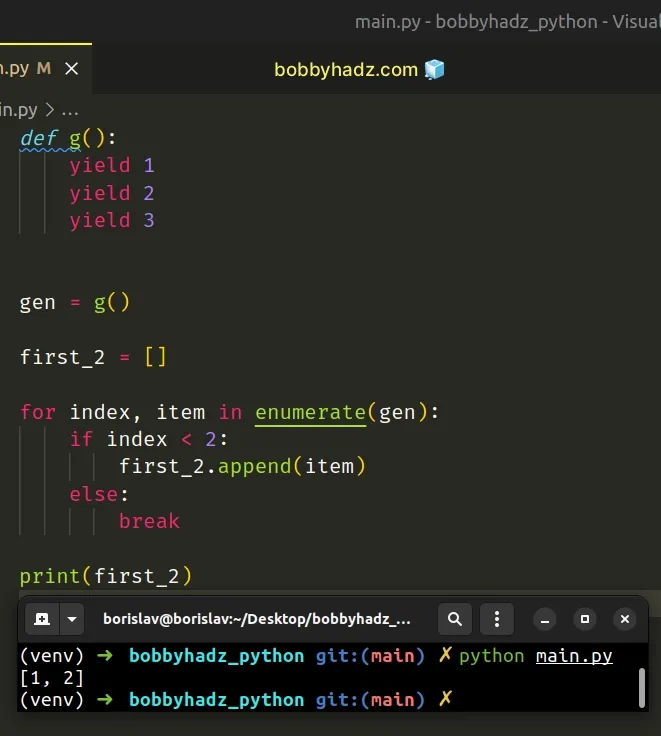Get first N elements or Nth element of a Generator in Python
Last updated: Apr 10, 2024
Reading time·7 min

# Table of Contents
- Get the first N elements of a Generator in Python
- Get a single element from a Generator in Python
- Get the Nth element of a Generator in Python
# Get the first N elements of a Generator in Python
To get the first N elements of a generator:
- Use the
islice()method to get an iterator of the first N elements. - Optionally convert the iterator to a list.
from itertools import islice def g(): yield 1 yield 2 yield 3 gen = g() first_2 = list(islice(gen, 2)) print(first_2) # 👉️ [1, 2]

If you need to get a single element from a generator, click on the following subheading.
The
itertools.islice()
method takes an iterator and optional start and stop indices.
We only specified a value for the stop index of 2, so the iterator object
only contains the first 2 elements of the generator.
The islice() method returns an iterator, but you can use the list() class if
you need to convert the result to a list object.
If your generator object isn't infinitely long, you can convert it to a list and use list slicing to get the first N elements.
def g(): yield 1 yield 2 yield 3 gen = g() my_list = list(gen) first_2 = my_list[:2] print(first_2) # 👉️ [1, 2]
The list class takes an iterable and returns a list object.
The syntax for list slicing is my_list[start:stop:step].
The start index is inclusive and the stop index is exclusive (up to, but not
including).
Python indexes are zero-based, so the first item in a list has an index of 0,
and the last item has an index of -1 or len(my_list) - 1.
We only specified a value for the stop index, so the list slice starts at
index 0 and goes up to, but not including index 2.
Alternatively, you can use the next() function.
# Get the first N elements of a Generator using next()
This is a three-step process:
- Use a list comprehension to iterate over a
rangeobject of length N. - Use the
next()function to return each item. - The new list will only contain the first N elements of the generator.
def g(): yield 1 yield 2 yield 3 gen = g() first_2 = [next(gen, None) for _ in range(2)] print(first_2) # 👉️ [1, 2]

We used the range() class to create a range object of length N.
print(list(range(2))) # 👉️ [0, 1] print(list(range(3))) # 👉️ [0, 1, 2]
On each iteration, we use the next() function to get an item from the
generator and return the result.
The next() function returns the next item from the provided iterator.
The function can be passed a default value as the second argument.
If the iterator is exhausted or empty, the default value is returned.
StopIteration exception is raised.We used None as the default value. If you need to filter out any None values
from the list, use a
list comprehension.
def g(): yield 1 yield 2 yield 3 gen = g() # 👇️ Get the first 2 elements of a generator next(gen) next(gen) first_2 = [next(gen, None) for _ in range(2)] print(first_2) # 👉️ [3, None] # 👇️ remove None values from the list first_2 = [item for item in first_2 if item is not None] print(first_2) # 👉️ [3]
Alternatively, you can use a for loop.
# Get the first N elements of a Generator using a for loop
This is a three-step process:
- Use a
forloop to iterate over the generator withenumerate(). - Check if the current index is less than N.
- If the condition is met, append the current item to a list.
def g(): yield 1 yield 2 yield 3 gen = g() first_2 = [] for index, item in enumerate(gen): if index < 2: first_2.append(item) else: break print(first_2)

We used the enumerate() function to get access to the index of the current
iteration.
The enumerate() function takes an iterable and returns an enumerate object containing tuples where the first element is the index and the second is the corresponding item.
my_list = ['bobby', 'hadz', 'com'] for index, item in enumerate(my_list): print(index, item) # 👉️ 0 bobby, 1 hadz, 2 com
On each iteration, we check if the current index is less than 2.
If the condition is met, we append the item to a list.
If the condition isn't met, we exit out of the loop.
The break statement breaks out of the
innermost enclosing for or while loop.
Which approach you pick is a matter of personal preference. If the generator is not infinitely long, I'd simply convert it to a list and use list slicing.
# Get a single element from a Generator in Python
Use the next() function to get a single element from a generator.
def g(): yield 1 yield 2 yield 3 gen = g() print(next(gen)) # 👉️ 1 print(next(gen)) # 👉️ 2 print(next(gen)) # 👉️ 3 print(next(gen, None)) # 👉️ None
You can get the first element of a generator by calling the next() function
once.
The next() function returns the next item from the provided iterator.
The function can be passed a default value as the second argument.
If the iterator is exhausted or empty, the default value is returned.
StopIteration exception is raised.We used None as the default value, but you can use any other value that suits
your use case.
def g(): yield 1 yield 2 yield 3 gen = g() print(next(gen, None)) # 👉️ 1 print(next(gen, None)) # 👉️ 2 print(next(gen, None)) # 👉️ 3 print(next(gen, None)) # 👉️ None
You can also use the list() class to convert the generator object to a list
and get one element at a time.
def g(): yield 1 yield 2 yield 3 gen = g() my_list = list(gen) print(my_list) print(my_list[0]) # 👉️ 1 print(my_list[1]) # 👉️ 2 print(my_list[2]) # 👉️ 3 print(list(gen)) # 👉️ []
List objects are subscriptable, so we can access the element at a specific index
after converting the generator object to a list.
You can also iterate over a generator object using a simple for loop.
def g(): yield 1 yield 2 yield 3 gen = g() for item in gen: print(item) # 👉️ 1, 2, 3
If you convert the generator to a list, make sure the index you are accessing exists.
Trying to access a list at an index that doesn't exist raises an IndexError
exception.
You can use a try/except statement if you need to handle the exception.
def g(): yield 1 yield 2 yield 3 gen = g() my_list = list(gen) print(my_list) # 👉️ [1, 2, 3] try: result = my_list[100] print(result) except IndexError: # 👇️ this runs print('List index out of range')
The specified index is out of range, so the except block runs.
# Get the Nth element of a Generator in Python
To get the Nth element of a generator:
- Use the
islice()method to get an iterator starting at index N. - Pass the iterator to the
next()function. - The
next()function will return the Nth element of the generator.
from itertools import islice def g(): yield 1 yield 2 yield 3 gen = g() second = next( islice(gen, 1, None), None ) print(second) # 👉️ 2
The
itertools.islice()
method takes an iterator and optional start and stop indices.
We used a start index of 0 and a stop index of None.
When stop is None, then iteration continues until the iterator is exhausted.
For infinitely long generators, the iteration stops at the specified position.
The next() function returns the next item from the provided iterator.
The function can be passed a default value as the second argument.
If the iterator is exhausted or empty, the default value is returned.
If the iterator is exhausted or empty and no default value is provided, a
StopIteration exception is raised.
None as the default value but you can use any other value that suits your use case.from itertools import islice def g(): yield 1 yield 2 yield 3 gen = g() item = next( islice(gen, 100, None), 'default value' ) print(item) # 👉️ default value
If your generator object isn't infinitely long, you can convert it to a list and access the list element at index N.
def g(): yield 1 yield 2 yield 3 gen = g() my_list = list(gen) print(my_list[0]) # 👉️ 1 print(my_list[1]) # 👉️ 2 print(my_list[2]) # 👉️ 3 print(list(gen)) # 👉️ []
The list class takes an iterable and returns a list object.
You can also use the enumerate() function to get access to the index of the
current iteration.
def g(): yield 1 yield 2 yield 3 gen = g() nthElement = next( (item for index, item in enumerate(gen) if index == 1), None ) print(nthElement) # 👉️ 2
The enumerate() function takes an iterable and returns an enumerate object containing tuples where the first element is the index and the second is the corresponding item.
On each iteration, we check current index is equal to a specific index.
If the condition is met, we return the corresponding item.
Which approach you pick is a matter of personal preference. I'd use the list()
class for non-infinite generator objects as conversion to a list is quite
intuitive and readable.
# Additional Resources
You can learn more about the related topics by checking out the following tutorials:

